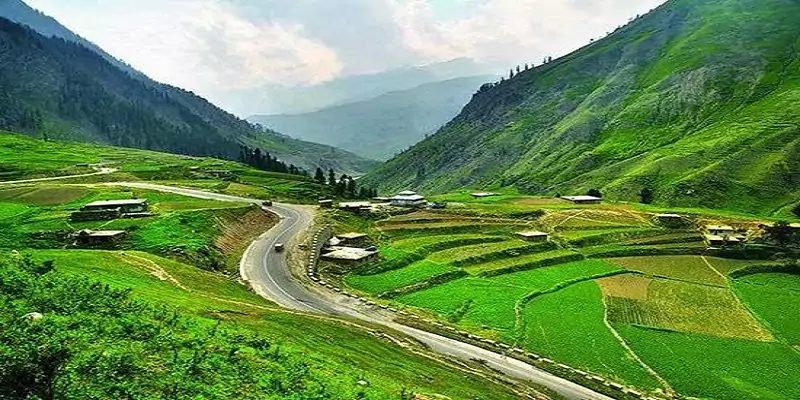Naran Valley
Naran Valley, cradled within the majestic embrace of the Himalayan range, is a gem in the northern reaches of Pakistan that captivates visitors with its breathtaking landscapes, pristine lakes, and a serene ambiance. In this comprehensive exploration, we will delve into the geography, history, culture, economy, education, landmarks, and the unique characteristics that define Naran Valley.
Naran Valley is located in the Mansehra District of the Khyber Pakhtunkhwa (KPK) province, nestled amidst the Himalayan peaks. It is part of the Kaghan Valley, a region renowned for its stunning scenery and captivating beauty. The valley is surrounded by towering mountains, including the Himalayas and the Babusar Pass, creating a landscape of unparalleled grandeur. The Kunhar River, originating from the glacial waters of Saif-ul-Mulook, flows through the valley, adding to its allure.
The history of Naran Valley is deeply intertwined with the broader historical narrative of the region. The Kaghan Valley, of which Naran is a significant part, has witnessed the passage of various civilizations, including the Gandhara civilization. Over the centuries, the valley has been traversed by conquerors, traders, and pilgrims, leaving behind traces of diverse cultures. However, due to its remote location, Naran retained its pristine charm, with communities living in harmony with nature.
Naran Valley, like many areas in the northern regions of Pakistan, reflects a unique blend of cultures influenced by Central Asian, Persian, and South Asian traditions. The local population, primarily consisting of ethnic Pashtuns and Kohistanis, embraces a lifestyle deeply connected to the mountains and the seasons. The cultural fabric is adorned with traditional music, dance, and handicrafts, providing visitors with an authentic experience of the local way of life.
The economy of Naran Valley revolves around tourism, agriculture, and livestock farming. The fertile lands along the Kunhar River support the cultivation of crops like wheat, barley, and potatoes. However, the region's real economic boost comes from tourism, with visitors flocking to Naran to witness its natural wonders. The local populace often engages in providing hospitality services, running guesthouses, hotels, and facilitating adventure tourism activities.
Given its remote location and focus on preserving its natural beauty, Naran Valley has limited educational infrastructure. The educational needs of the local population are often met by schools in nearby towns. Efforts are underway to enhance educational facilities and promote literacy, ensuring that the younger generation has access to quality education.
Landmarks and Attractions:
1. Saif-ul-Mulook Lake:
Crown jewel of Naran, Saif-ul-Mulook is a pristine alpine lake surrounded by snow-capped peaks. Legend has it that fairies reside near its shores, adding a touch of mystique to its charm.
2. Babusar Pass:
Connecting Naran to Gilgit, the Babusar Pass is a high-altitude mountain pass offering panoramic views of the Himalayas. The journey through this pass is an adventure in itself.
3. Lulusar Lake:
Lulusar Lake, the largest natural lake in Hazara, is surrounded by snow-capped mountains. It serves as a starting point for the Kunhar River.
4. Jheel Saif-ul-Mulook:
A smaller lake adjacent to Saif-ul-Mulook, Jheel Saif-ul-Mulook is equally enchanting, reflecting the surrounding peaks in its crystal-clear waters.
5. Shogran:
A picturesque hill station near Naran, Shogran offers panoramic views of the Himalayas. It's a serene retreat and a base for trekking adventures.
Naran Valley is a haven for tourists seeking an escape into the lap of nature. The valley attracts adventure enthusiasts, nature lovers, and those seeking tranquility. Tourists embark on trekking expeditions, jeep safaris, and enjoy the unparalleled beauty of the landscape. The summer months witness an influx of visitors eager to explore the valley's wonders.
Naran Valley experiences a temperate climate during the summer, making it an ideal escape from the scorching heat of the plains. However, the winter season blankets the valley in snow, turning it into a winter wonderland. The cold season adds a different dimension to Naran's beauty, attracting winter sports enthusiasts and those seeking a snowy retreat.
The infrastructure in Naran Valley has seen improvements in recent years, primarily driven by the increasing influx of tourists. Roads connecting Naran to other parts of KPK have been upgraded, and accommodations ranging from budget guesthouses to luxury resorts cater to the diverse needs of visitors. Ongoing efforts focus on sustainable tourism practices to preserve the valley's ecological balance.
Naran Valley faces challenges related to environmental conservation due to the surge in tourism. Unregulated tourism can impact the delicate ecosystem, and efforts are being made to implement sustainable practices. Conservation initiatives include waste management, afforestation projects, and awareness campaigns to instill a sense of responsibility among visitors.
As Naran Valley continues to capture the hearts of those seeking natural beauty and adventure, the future holds both opportunities and challenges. Sustainable tourism practices, community involvement, and environmental conservation efforts are key components of the valley's vision for the future. Striking a balance between tourism and preservation ensures that Naran remains a pristine paradise for generations to come. Naran Valley stands as a testament to the awe-inspiring beauty of northern Pakistan. Its shimmering lakes, majestic mountains, and vibrant culture create an environment that resonates with visitors from around the world. Naran is not just a destination; it

